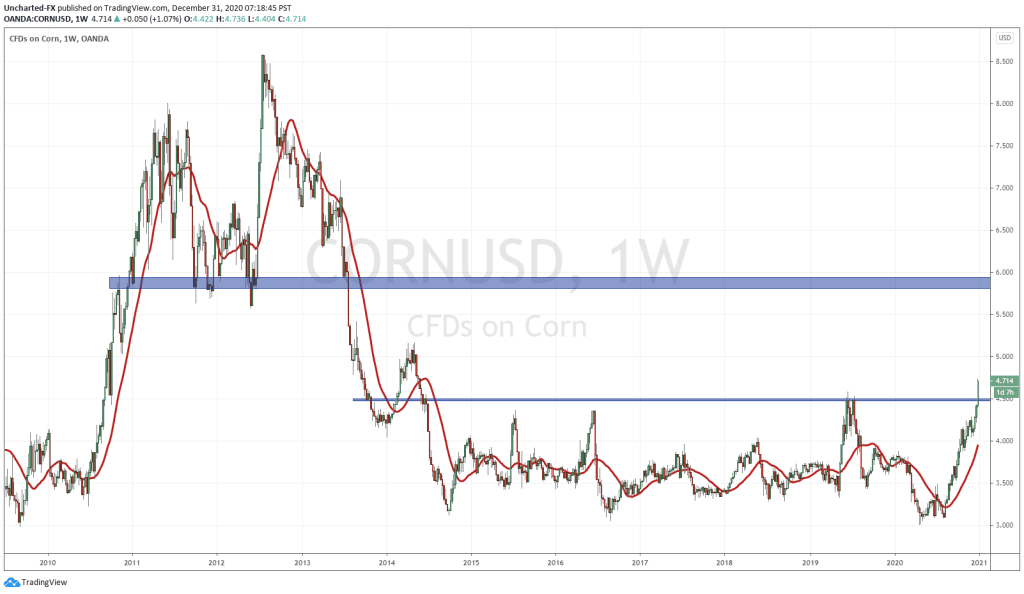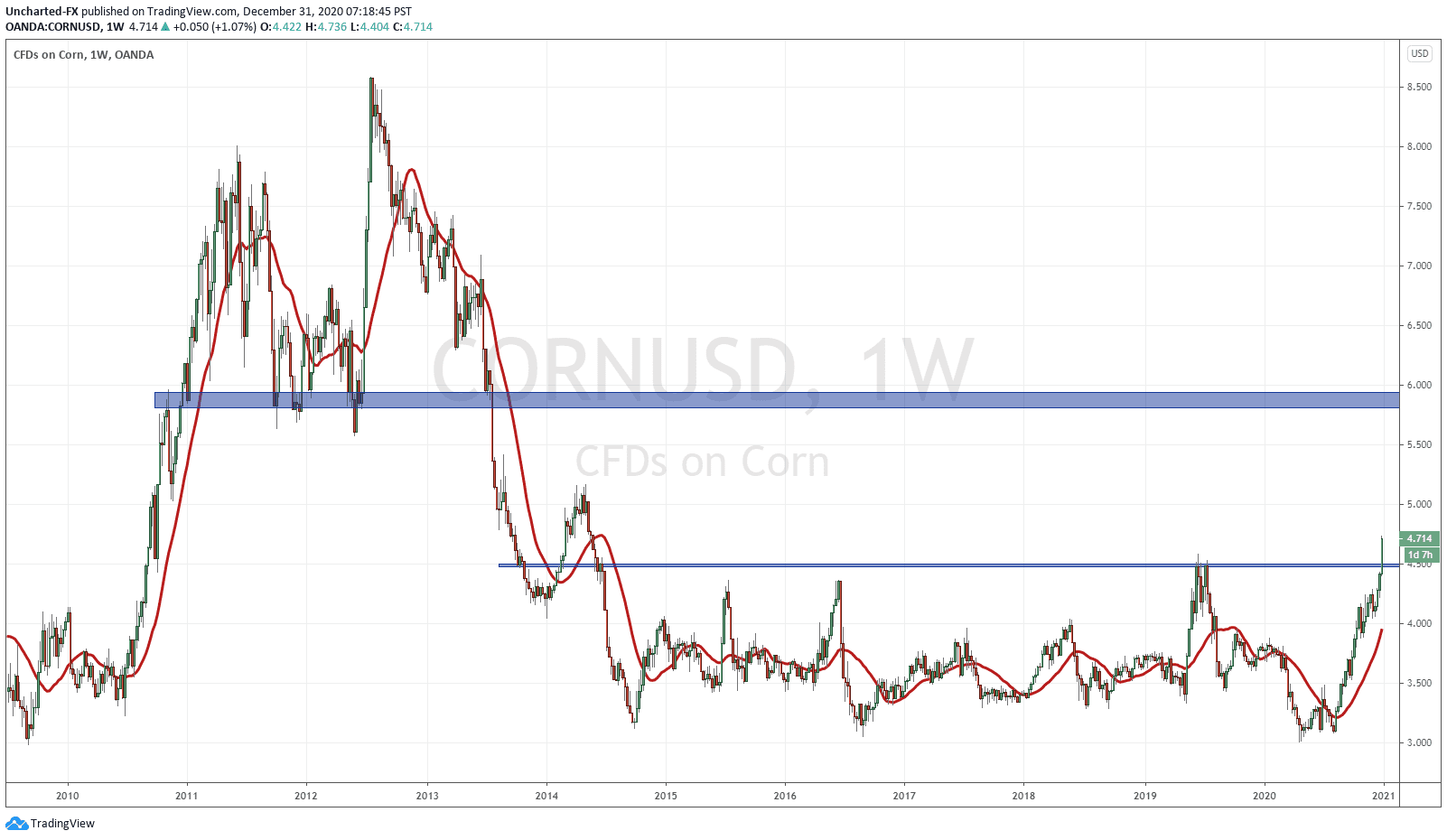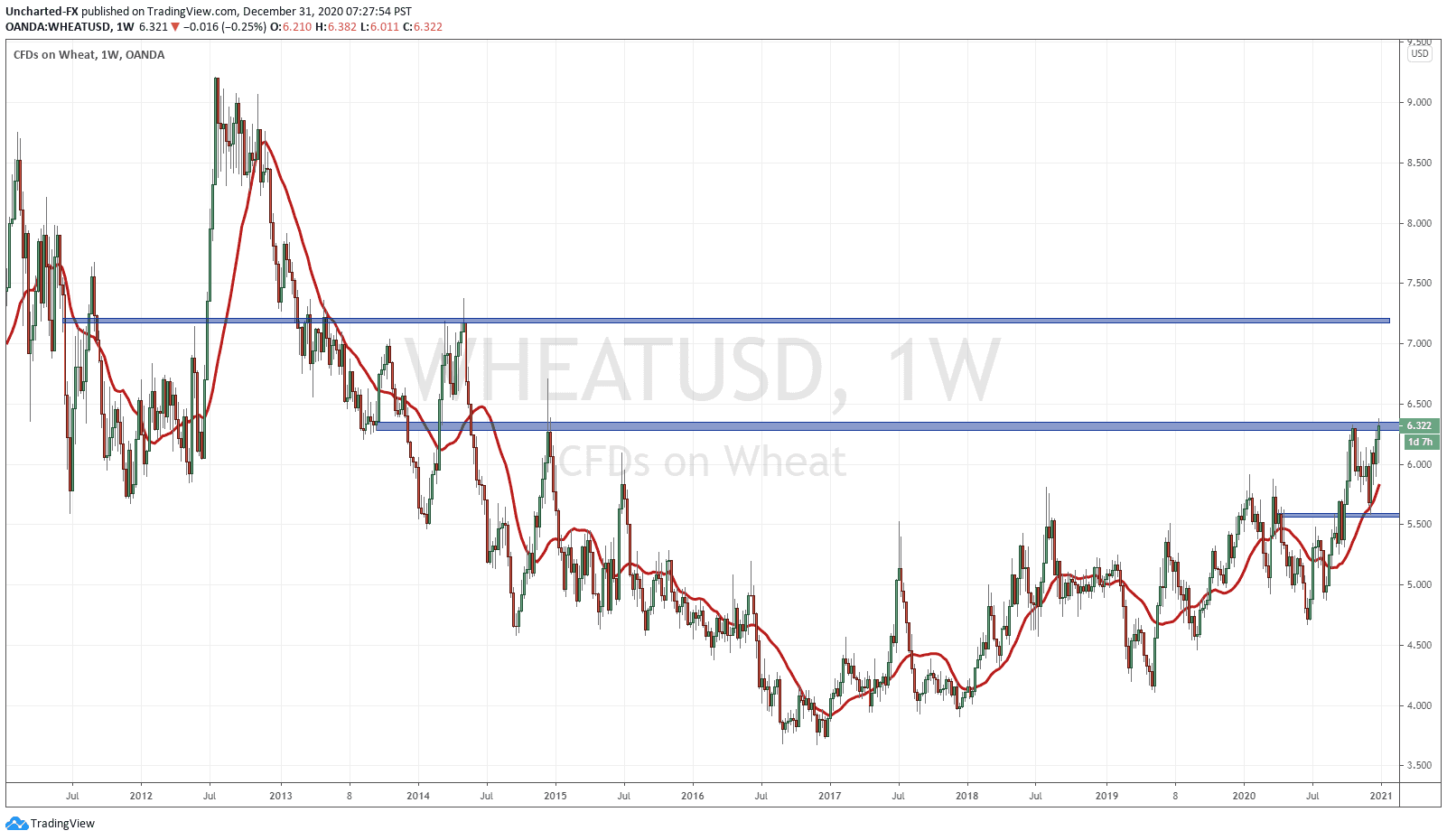Ending my posts of major themes to look for in 2021, I want to end with the agricultural commodities. Particularly Corn, Wheat and Soybeans. The agricultural commodities are some of my favorite assets to trade, and I do not think many people pay too much attention to them. I focus on the three mentioned above, but you can also trade sugar, coffee, cocoa, orange juice (yes seriously), cattle, hogs, and pork bellies to name a few more
Let me give you a quick run down on the ag commodities.
Corn is the most traded agricultural commodity, and is an important food source for both humans and animals. What makes Corn important is that it can be grown in a variety of climates and conditions, unlike the other agricultural commodities. Other uses include starches, corn oil and fuel ethanol. According to my handy dandy commodity handbook, approximately 35 million hectares are used exclusively for corn production world wide.
Just as Oil has different qualities (Brent, West Texas, Canadian West etc), Corn does as well. There are different grades but the most important are high grade number 2 corn and number 3 yellow corn.
The futures ticker for corn contracts is ZC. The top 5 producers of Corn in the world are: The United States, China, Brazil, Mexico and India (Canada makes it in 9th place). For those interested in exploring more about corn, visit corn.org.
Corn has had an amazing run since June. We will get to the why when at the end of this post, but pay attention to the commodity charts. These are all going to be LONG term weekly charts. You can see that Corn is breaking out, and in fact, will confirm a breakout with this weeks close, which occurs today. Lot of room higher to go in 2021. The breakout zone will be our support, and as long as we remain above, Corn moves higher.
Wheat is the second most produced agricultural commodity. Rice comes in at third for those that are interested. No country necessarily dominates wheat production a la Saudi Arabia with Oil and Kazakhstan with Uranium.
China, India, Russia, the United States, and France produce the most wheat in the millions of tons. Canada, Australia, Germany, Pakistan, and Ukraine also boast significant production.
The future contract ticker for Wheat is ZW. For those interested in wheat, visit wheatworld.org.
Wheat on the weekly is setting up to breakout. Just like Corn, we would confirm a breakout on the weekly chart by the end of today.
Finally, Soybeans. Perhaps the more ‘mainstream’ financial media agricultural commodity that has seen plenty of coverage due to the US-China trade deal. Part of the phase 1 deal was for China to increase their purchases of US Soybeans.
I am focusing on the the whole soybean, but most soybeans are used for soybean oil and soybean meal. For those interested in Soybeans, visit soygrowers.org.
The United States dominates the Soybean market, composing 50% of the total global production. Brazil comes in second at around 20%. Many analysts predicted Brazil to be the big winner in a US-China trade war spat, as China could look to Brazil for more Soybean exports.
The futures contract for Soybeans is ZS. Let’s take a look at the other traded forms of soybeans which have their own futures ticker.
Soybean Oil is a vegetable oil and is one of the most used culinary oil in the world. Soybean Oil is also popular as a biodiesel. Believe it or not, but there are cars that have engines which can convert from regular diesel to Soybean Oil during production. They are known as ‘frybrids’. The futures ticker for Soybean Oil is ZL.
Soybean Meal is a quick one. Whatever is left from the extraction of Soybeans into Soybean Oil can be converted into Soybean Meal. This is used for high-protein, high-energy food for feedstock for cattle, hogs, and poultry. The futures contract for Soybean Meal is ZM.
Soybeans have been ripping in 2020. Again, China demand and the US-China Trade war headlines play a large part, but there was some other factors which we will discuss soon. Just like Corn and Wheat, Soybeans is set to confirm yet another breakout with a weekly candle close today.
The agricultural commodities do not get the attention they deserve, and as you can see, they have made huge moves. For traders, they present a great trade opportunity due to the volatility, but also add on some more risk. Consider at least watching them if you do not want to trade them.
M readers know I am extremely bullish on the agricultural commodities and agriculture in general. Jim Rogers is the one who got me excited about this sector. His argument is that most young people do not want to become farmers anymore, and that the average age of farmers is well above 60. Governments may need to create larger incentives to get young people to take up farming.
I see some issues and challenges for agriculture, but will be rectified by human ingenuity. The first issue is soil. A lot of soil sucks due to the pesticides and other chemicals we use. If the soil is not great, the crop will not have the full dose of nutrients and could lead to health issues down the road. As many of you are aware, the organic food movement is a huge trend, and will grow year by year. Soil replenishment will be big. I have head some things in the past about zinc being used to replenish soil, particularly in California. Phosphorus and Potash also come in mind. In fact, some foresee a phosphorus faming crisis.
A big issue for farming has been climate change. Obviously farming is cyclical. Winter has been lingering longer, especially on the East Coast. Farmers tend to await for certain birds to return to let them know Spring is here and it is time to plant crops. But Spring has been coming later while Winter lingers longer. Climate change will continue to disrupt agriculture and this could lead to a shortage of crops.
In fact, this is the primary reason for the spike in Corn and Soybeans this year. Iowa is where the majority of these crops are grown in the US. Millions of acres were destroyed due to the storm in Iowa in August. This has led to spikes in agricultural commodities, and some say, points to a food crisis in 2021.
Finally, something not many people consider are the ramifications of green energy. This info I learned from Peter Zeihan’s book, “Disunited Nations“. Highly recommended for anyone with an interest in geopolitics and where the world is going in the future.
Green energy is coming. We all know it. Governments will be spending a lot for green infrastructure. Due to the fiscal policy required to combat covid, taxes need to go up. The best way is through green taxes because they know the people will not complain. Government will say these taxes are going to be used for green infrastructure which will aid in an economic recovery and creating jobs.
The issue, as Mr. Zeihan states, is that solar panels and wind turbines need to be put in areas that are very sunny and/or windy. These areas tend to be where the best agricultural land is situated. So nations would have to sacrifice agriculture for energy. In his book, Zeihan states that there only a few nations which can come out as winners in this predicament. China is not one of them.
Do not panic, a lot of these issues can be remedied. In house and Greenhouse farming can be a way to cope with the effects of climate change and unpredictable weather patterns. Vertical integrated farming can be a solution to allow for green energy infrastructure to be built in the best agriculture lands, and can also be a solution for nations that do not have much agricultural lands. So yes there will be issues, but human ingenuity will get us through it. The question is how long will it take?
I want to end of with Covid. It seems we are setting up for a food crisis next year. Tons of articles about supply chain disruptions due to covid and worsening food insecurity for many nations. If this winter turns out to be a dark winter due to covid cases, the likelihood of empty shelves increases.
A lot of this could also have an impact on the prices of agricultural commodities. Canada is already preparing for this. In Canada’s Food Price Report 2021, bread, meat and vegetable prices are set to rise between 3-5% in 2021. The average Canadian family will pay up to $700 more for food in 2021.
The agricultural charts are pointing to higher food prices. Covid and Climate will have impacts, and hence why I am bullish on this sector going forward.




